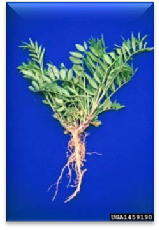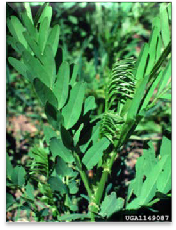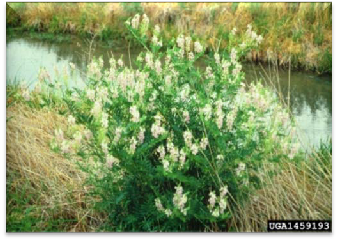Goat’s rue is a Class A Noxious Weed. Non-native species that is limited in distribution in Washington. State law requires that these weeds be eradicated.
Goat’s rue, (Galega officinalis L.), native to the Middle East, is a deep-rooted perennial herb that is a federally listed noxious weed. Goat’s rue reproduces by seed. The plant has a vigorous crown and a deep taproot and produces up to as many as 20 robust stems. The stems are hollow, cylindrical, and tubular and grow 2−6 feet tall. The leaves of the plant are alternate along the stem, 7−9 inches long, and compound with 4−10 pairs of leaflets plus a terminal leaflet. Each leaflet has  a small hair-like projection at its tip. The plant’s stems and leaves contain a poisonous alkaloid galegin) which renders the plant unpalatable to most livestock and fatal to ruminants (especially sheep) when consumed in large quantities—the alkaloid content is highest in the spring. Goat’s rue begins flowering in June and continues to produce flowers and fruits until frost. The flower spikes are made up of white to bluish/purplish pea-like blossoms that are borne along the ends of branches similar to a snapdragon. Each blossom produces a straight, narrow, smooth pod, with up to 9 oblong, dull, mustard-yellow seeds per pod. Seeds drop to the ground when mature and are typically spread by water, equipment, or animals. Seeds can remain viable in the soil for 5−10 years.
a small hair-like projection at its tip. The plant’s stems and leaves contain a poisonous alkaloid galegin) which renders the plant unpalatable to most livestock and fatal to ruminants (especially sheep) when consumed in large quantities—the alkaloid content is highest in the spring. Goat’s rue begins flowering in June and continues to produce flowers and fruits until frost. The flower spikes are made up of white to bluish/purplish pea-like blossoms that are borne along the ends of branches similar to a snapdragon. Each blossom produces a straight, narrow, smooth pod, with up to 9 oblong, dull, mustard-yellow seeds per pod. Seeds drop to the ground when mature and are typically spread by water, equipment, or animals. Seeds can remain viable in the soil for 5−10 years.
Goat’s rue is found along roadsides, stream banks and fence lines and in cropland, pasture, and wet, marshy areas. It prefers full sun, but will tolerate light shade. Goat’s rue is capable of forming monocultures in wetland communities, displacing native or beneficial plants.
Goat’s rue can be confused with crown vetch (Coronilla varia), but it is taller when upright and has a spike-shaped cluster of flowers. Wild licorice (Glycyrrhiza lepidota) also resembles goat’s rue, but it does not need to be eradicated. Wild licorice is commonly found in meadows, pastures, ditches and along river banks. The root of wild licorice is sweet and was an important food source for Native Americans. The stems are useful in distinguishing the 2 plants: goat’s rue plants have hollow stems while wild licorice stems are solid. Wild licorice also has bur-like seed pods with hooked bristles, while goat’s rue seed pods are narrow and smooth. County weed coordinators should always be consulted if there is any question about the identity of a plant.
Control Method
Mechanical/Cultural Control: Small goat’s rue plants can be pulled or grubbed out, although care needs to be taken to remove the entire root system to prevent re-sprouting. Mowing, clipping, cutting, and shallow cultivation alone are not recommended; goat’s rue plants will flower and produce seeds even when cut short. Alternate cropping and row crops are effective deterrents since cultivation interrupts the life cycle of goat’s rue.
Chemical Control: Goat’s rue can be effectively controlled using any of several readily available general use herbicides such as glyphosate. Selective herbicides are considered the most effective for large sites. Dicamba, or 2,4-D and their combinations are very effective. Crowns of treated plants may remain viable up to 7 years unless retreated or excavated and removed.
More information can be found in the PNW Weed Management Handbook
Use pesticides with care. Apply them only to plants, animals, or sites listed on the label. When mixing and applying pesticides, follow all label precautions to protect yourself and others around you. It is a violation of the law to disregard label directions. Store pesticides in their original containers and keep them out of the reach of children, pets, and livestock.
Biological Control: No biological control options are available.
Questions: contact Steve Van Vleet or phone (509) 397 – 6290
Photo credits included in PDF





